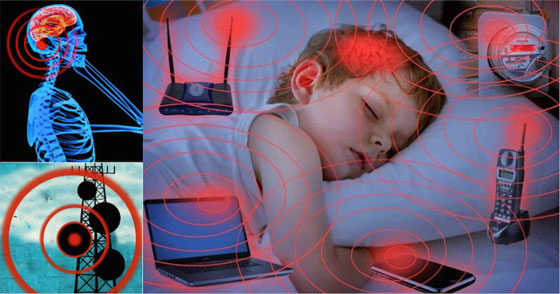The radiation RF-EMF causes damage to DNA, increase the temperature of tissues, and disrupt the blood-brain barrier. These effects are real and ARPANSA is active in collaborating with the EHS community, medical specialists as well as researchers. ARPANSA will continue to review research on the health effects caused by EMF radiation.
RF-EMF causes DNA damage
Exposure to man-made electromagnetic fields (EMFs) can cause DNA damage, as well as other negative health adverse effects. EMFs can affect intracellular ionic concentrations, which are essential to ensure the electrochemical balance of cells. This can disrupt cell homeostasis, resulting in DNA damage. Moreover, exposure to EMFs can also trigger an increase in the production of free radicals as well as reactive oxygen species (ROS).
Exposure to RF-EMF radiation has been associated with changes in the development of male germ cells. This is due to the development of germ cells into spermatozoa, aswell as functional maturation as the spermatozoa move throughout the epididymis. To investigate the effect of RF-EMF exposure on male germ cell development, a specially-built waveguide machine was designed for the purpose of exposing mice that were not restrained to RF-EME with a dose of 2.2 W/kg.
In a recent study, researchers found that exposure to RF-EME caused the oxidative DNA damage of the spermatozoa. Sperm DNA fragmentation was increased by 18% after an entire week of treatment and by 23 percent after five weeks. Furthermore, DNA damage in mitochondria was observed by measuring the level of a biomarker, 8-hydroxy-2-deoxyguanosine (8-OH-dG).
However, the RF-EMF radiation has not yet been classified as a cancer-causing agent. However, Go to the website have revealed that RF-EMF exposure can impair the integrity of DNA in range of cell types. In one study scientists subjected Vero cells with an EMF of 100 Hz for about 45 minutes. They measured DNA damage 48 hours after exposure to determine if exposure affected DNA integrity.
The RF-EMF effect causes the heating of tissues
While the effects of RF EMF are generally thought to have thermal origins, a few studies have revealed that non-thermal effects are also observed. These factors could be responsible for some of the unresolved issues in the epidemiological study of EMF hypersensitivity. This is why it is crucial to look at the non-thermal aspects when conducting an exhaustive review.
The non-thermal effects of RF-EMF could occur at the cell membrane. This is a field of research that has been thoroughly examined. Particularly, the electrochemical behavior of cell membranes has been studied. Current understanding suggests that RF-EMF energy that exceeds 1 MHz is transmitted to the tissue via dielectric and Ionic dissipation. Previous theoretical analyses indicated that the energy that is transferred to tissues could be as high as 200 kV/m.
The electrical properties of tissues are controlled by the composition and distribution of water molecules, ions, and other substances in the body. This determines how absorbed EMR from RF is absorbed by different tissues. The tissues with the highest conductivity tend to absorb more of the field, and thus cause more of an effect. is emf radiation harmful is why the level of heat generated by tissue doesn't increase continuously between the outside and inside the body, but occurs in hot areas. Bone and fatty tissue are less susceptible to RF heating as compared to other tissues, since they are low in water content.
The extent of penetration of the electromagnetic field is determined by the frequency and strength that the electromagnetic field has. Muscle tissue is more able to absorb field radiation than most tissues and transforms it into heat more effectively. Typically the depth of penetration of RF-EMF is measured by millimeters (mm). The higher the frequency, the shallower the penetration.
RF-EMF causes blood-brain barrier disruption
Researchers have found that RF-EMF could disrupt the blood-brain barrier which can alter sleep patterns and neurotransmitter levels. Furthermore https://telegra.ph/How-EMF-Radiation-Impacts-Your-Body-03-29-8 on the effects of EMF on brain activity have been associated with neurodegenerative disorders. For instance, EMF from mobile phones can affect electroencephalogram activity and sleep patterns, and the activity of nitric oxide and xanthin oxide.
Researchers at the Vienna University have studied the effects of exposure to RF EMF to brain cells. They also studied how ELF EMFs on the brain system. Though the cellular mechanisms that are involved aren't fully understood but there is a clear connection between exposure to ELF-EMF and myelin depletion. This relationship might account for the electro-hypersensitivity symptoms of electro-hypersensitivity. However, there are proven methods for regenerating myelin inside the brain.

Researchers have discovered that exposure to 900 MHz EMF enhanced the permeability of the BBB and increased symptoms of neuronal damage in rats. They also observed increased exovasation of albumin into neurons. Further, they found the following: after 30 mins of exposure at 900 MHz, 99mTc-MIBI increased its penetration to the cerebral cortex. However this effect didn't occur with Evans blue injections.
However, RF-EMF does not have a clear method for disrupting the BBB. Research suggests that EMF exposure increases erythrocyte membrane permeability. This could affect the BBB and enhance calcium ion efflux. Additionally, the presence of a 99mTc-MIBI radiotracer in the brain has been linked to increased permeability of the BBB.
